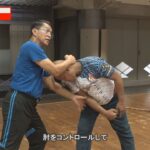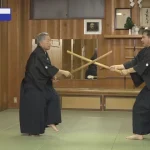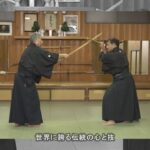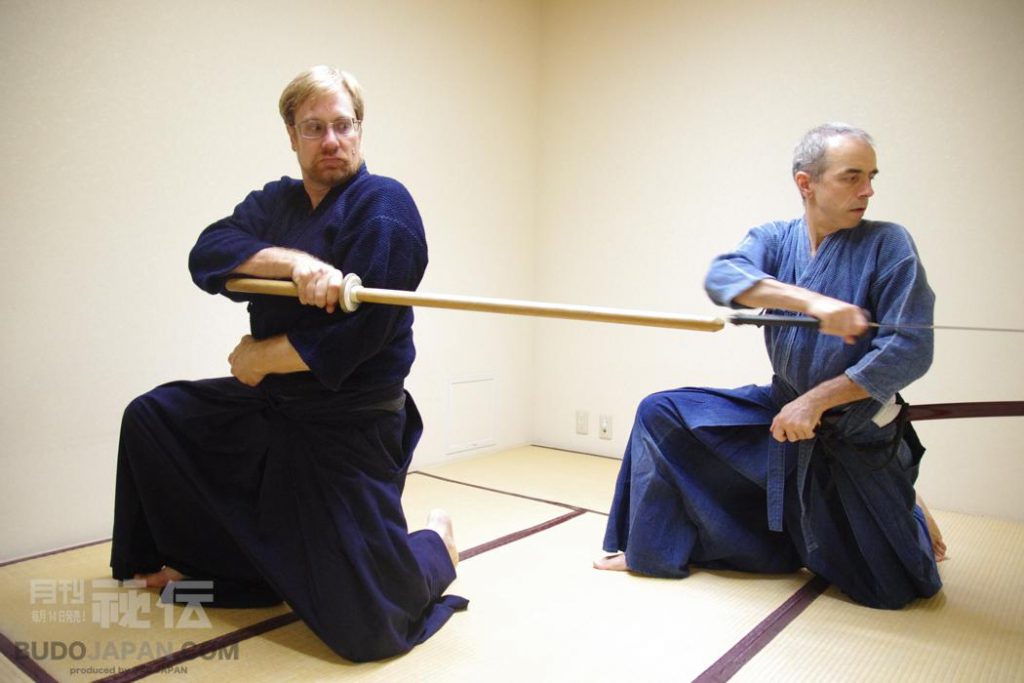
Text by Grigoris A.Miliaresis
The Budo Bum
It’s been almost 10 years since I first set foot in Japan and during these years I have been fortunate to have seen some of the best this culture has to offer in terms of martial arts; a big part of that I owe it to “Hiden” which, as usually happens with media, has provided me with a master key that unlocks the doors of dojo all over the country. From Japan Karate Federation sport karate (more on that on a future issue!) to small ryu practicing in back yard dojo, I have seen not all, of course, but quite many and I feel that my understanding of martial arts has become much broader and, perhaps, quite deeper.
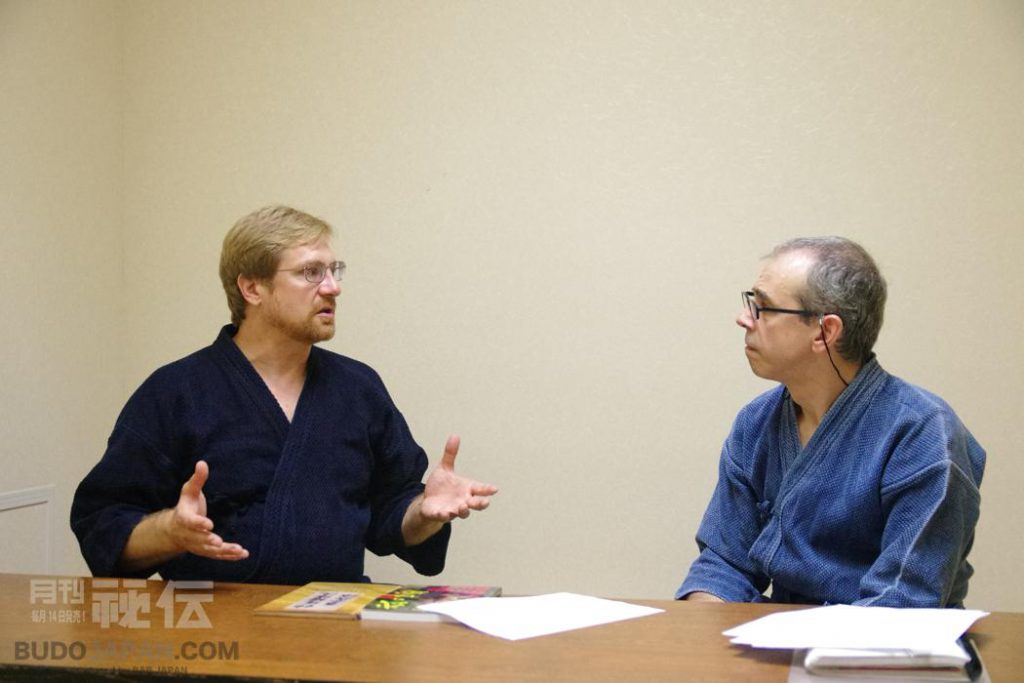 Oddly enough, one of the smallest schools I’ve come across I don’t owe to either “Hiden” or my being in Japan: instead, I know about its existence and its techniques because almost 20 years ago I decided to participate in an online forum (actually a mailing list) called “Aikido-L” where, as the name suggests, people who practiced aikido (or had some interest in it) got together to discuss it. I too joined because I had just started doing aikido and among the people that stood out was an American called Peter Boylan who although not an aikido practitioner, seemed to get along fine with everyone. And rightly so because, as was obvious from all his posts, he was a genuine “good guy”.
Oddly enough, one of the smallest schools I’ve come across I don’t owe to either “Hiden” or my being in Japan: instead, I know about its existence and its techniques because almost 20 years ago I decided to participate in an online forum (actually a mailing list) called “Aikido-L” where, as the name suggests, people who practiced aikido (or had some interest in it) got together to discuss it. I too joined because I had just started doing aikido and among the people that stood out was an American called Peter Boylan who although not an aikido practitioner, seemed to get along fine with everyone. And rightly so because, as was obvious from all his posts, he was a genuine “good guy”.
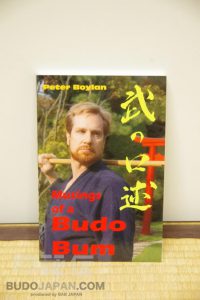 Peter was my age and had been practicing pretty much as long as me; his arts were judo, All-Japan Kendo Federation iaido and jodo, Shinto Muso-ryu jo and Shinto Hatakage-ryu Iai Heiho and unlike me (then) he had spent several years in Japan and was returning to it at least once a year to visit with family (his wife is Japanese) and friends (his social circle in Japan includes pottery artists and swordsmiths) and to continue his jo and iai education. He also had an online martial arts’ equipment and a blog, “The Budo Bum” which with time would give birth to a fine tome of essays titled “Musings of a Budo Bum” (“Bu no Kojutsu”).
Peter was my age and had been practicing pretty much as long as me; his arts were judo, All-Japan Kendo Federation iaido and jodo, Shinto Muso-ryu jo and Shinto Hatakage-ryu Iai Heiho and unlike me (then) he had spent several years in Japan and was returning to it at least once a year to visit with family (his wife is Japanese) and friends (his social circle in Japan includes pottery artists and swordsmiths) and to continue his jo and iai education. He also had an online martial arts’ equipment and a blog, “The Budo Bum” which with time would give birth to a fine tome of essays titled “Musings of a Budo Bum” (“Bu no Kojutsu”).
After a few public exchanges, we started communicating personally through email (I bought some clothes and equipment from him and his service was personal and exemplary) and then we had the chance to meet in Greece and in Germany during social and martial arts’-related visits. And since I came to Japan, I’ve been one of his Tokyo links -his connections are almost 100% in Kansai since this is where he lived during his stay in Japan- and every time he visits, we try to spend some time together and chat about, well, mostly martial arts but also about life in the US and Japan, the universe and everything.
Classic iai
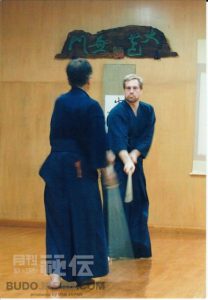 Most of the things Peter practices are very easily available, especially in Japan: judo is literally everywhere and so are AJKF jodo and iaido; Shinto Muso-ryu is a koryu but one would argue that together with Muso Jikiden Eishin-ryu and Muso Shinden-ryu it’s the most popular classic school mostly because of the work of Takaji Shimizu (1896–1978) both before and after WWII. But when it comes to classic iai, his school of choice is one that I (and most people I know) have never even heard of! Still, he not only has been practicing it for decades, he’s also one of the two licensed “jun shihan” of the tradition; in essence one of the two people responsible for its continuation.
Most of the things Peter practices are very easily available, especially in Japan: judo is literally everywhere and so are AJKF jodo and iaido; Shinto Muso-ryu is a koryu but one would argue that together with Muso Jikiden Eishin-ryu and Muso Shinden-ryu it’s the most popular classic school mostly because of the work of Takaji Shimizu (1896–1978) both before and after WWII. But when it comes to classic iai, his school of choice is one that I (and most people I know) have never even heard of! Still, he not only has been practicing it for decades, he’s also one of the two licensed “jun shihan” of the tradition; in essence one of the two people responsible for its continuation.
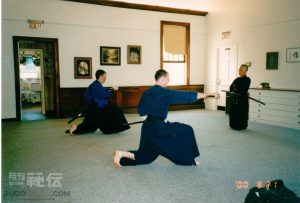 During one of our meetings in Germany, I had the chance to go through the school’s (as I mentioned before, it’s called Shinto Hatakage-ryu Iai Heiho) curriculum with Peter and a few other friends living there at the time during an informal “seminar”. It’s only 22 kata, six from seiza (Seiza no Bu) namely, Mae, Gekko, Sanbonme, Nuki Uchi, Kesa and Ropponme, six from tate hiza (Tate Hiza no Bu): Kesa, Nihonme, Suigetsu, Sanpo Tsume, Gohonme Tobichigai, Ropponme and ten standing (Tachiwaza no Bu) which are Oigiri, Nihonme, Sanbonme, Yohonme, Hasso, Ropponme, Sanpo Tsume, Suigetsu, Kyuhonme and Uke Nagashi and at first it looks like standard iai very close to what is taught under AJKF –until you start noticing some details!
During one of our meetings in Germany, I had the chance to go through the school’s (as I mentioned before, it’s called Shinto Hatakage-ryu Iai Heiho) curriculum with Peter and a few other friends living there at the time during an informal “seminar”. It’s only 22 kata, six from seiza (Seiza no Bu) namely, Mae, Gekko, Sanbonme, Nuki Uchi, Kesa and Ropponme, six from tate hiza (Tate Hiza no Bu): Kesa, Nihonme, Suigetsu, Sanpo Tsume, Gohonme Tobichigai, Ropponme and ten standing (Tachiwaza no Bu) which are Oigiri, Nihonme, Sanbonme, Yohonme, Hasso, Ropponme, Sanpo Tsume, Suigetsu, Kyuhonme and Uke Nagashi and at first it looks like standard iai very close to what is taught under AJKF –until you start noticing some details!
Kaiten chiburi
The first thing that jumps out is the kaiten chiburi, the fast rotation of the sword’s tsuka (hilt) in the left palm that supposedly makes the blood from the recent cut flying all over –like most people, I’ve only seen this performed in the kata of the Tenshin Shoden Katori Shinto-ryu and this, together with the school’s name confirms the story that its founder was a student of Shinto-ryu and that Shinto Hatakage-ryu is a long-separated branch of the famous Kanto school. No one really knows when this happened (even Peter’s teacher, and the person responsible for teaching him the school, Hiroshi Kiyama isn’t sure) but the relationship certainly exists.
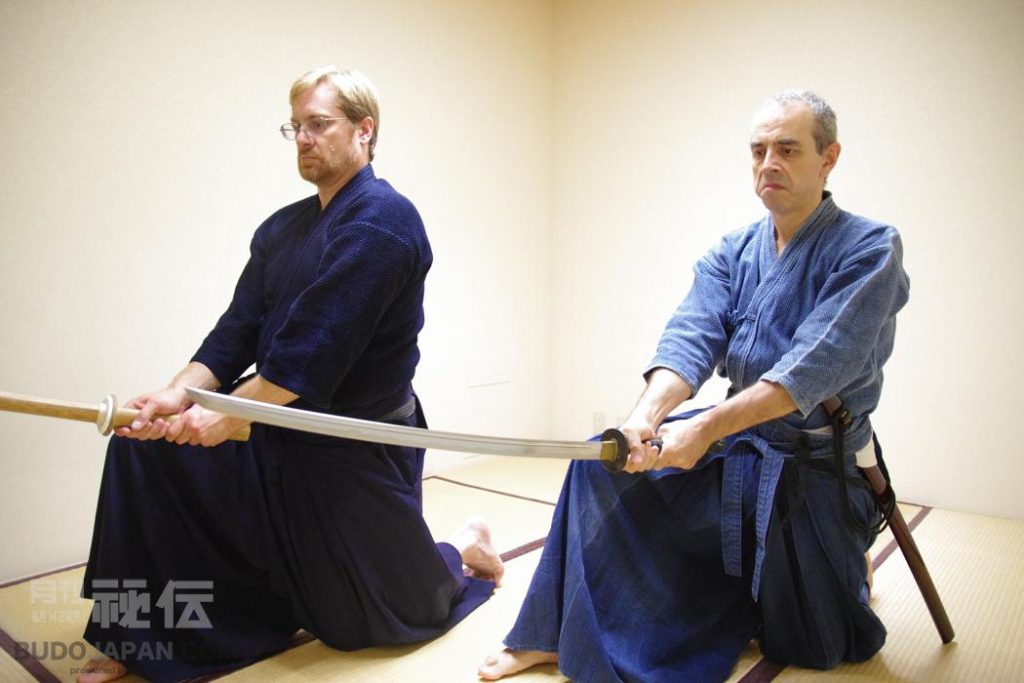
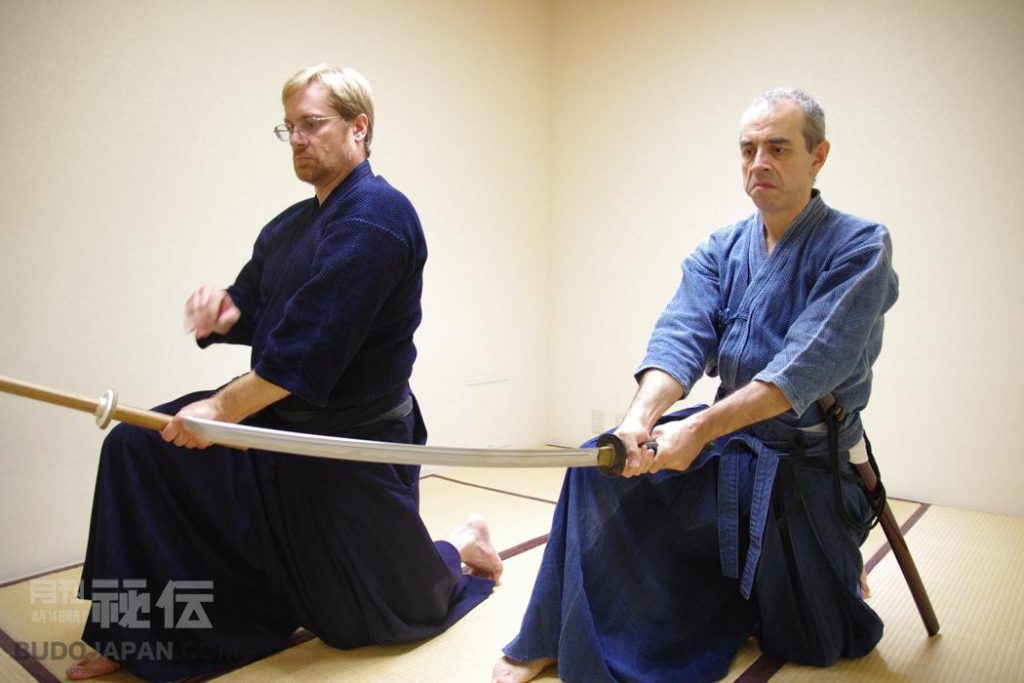
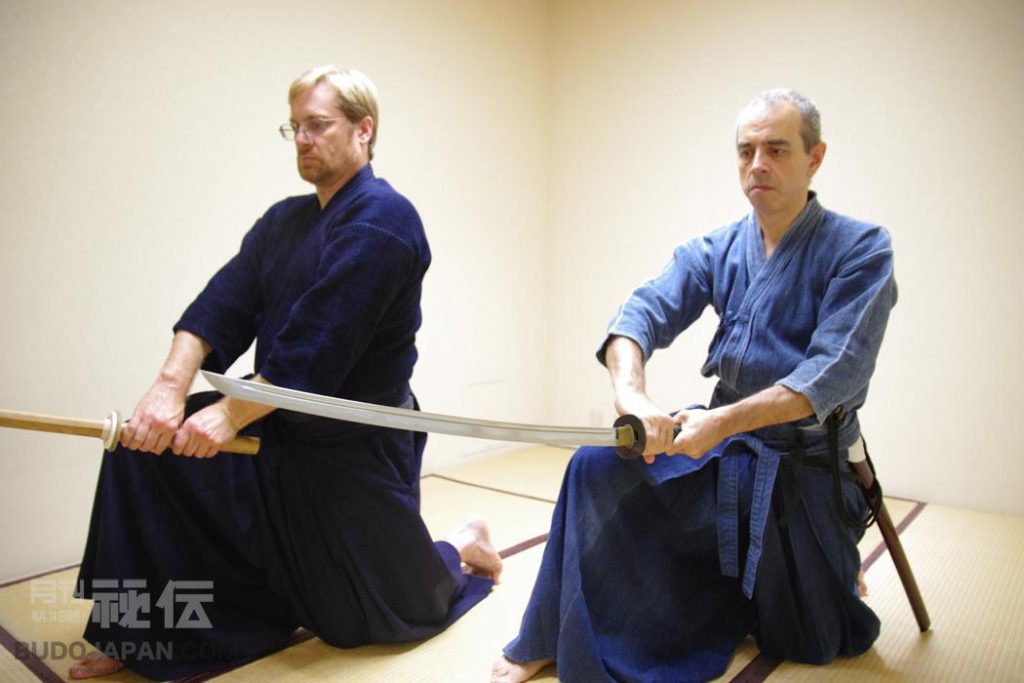
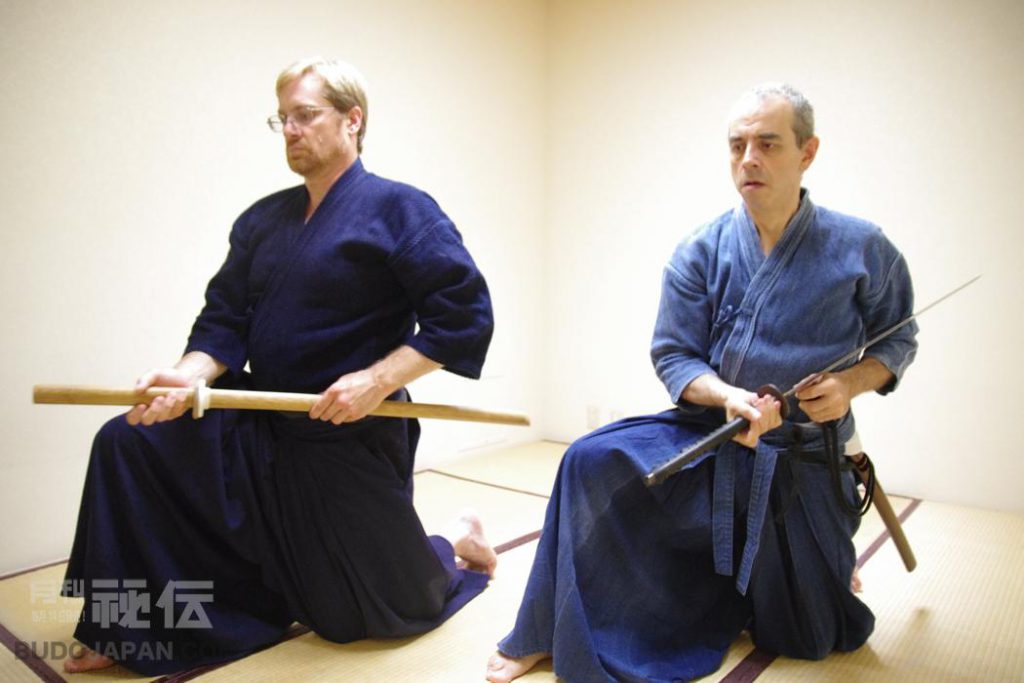
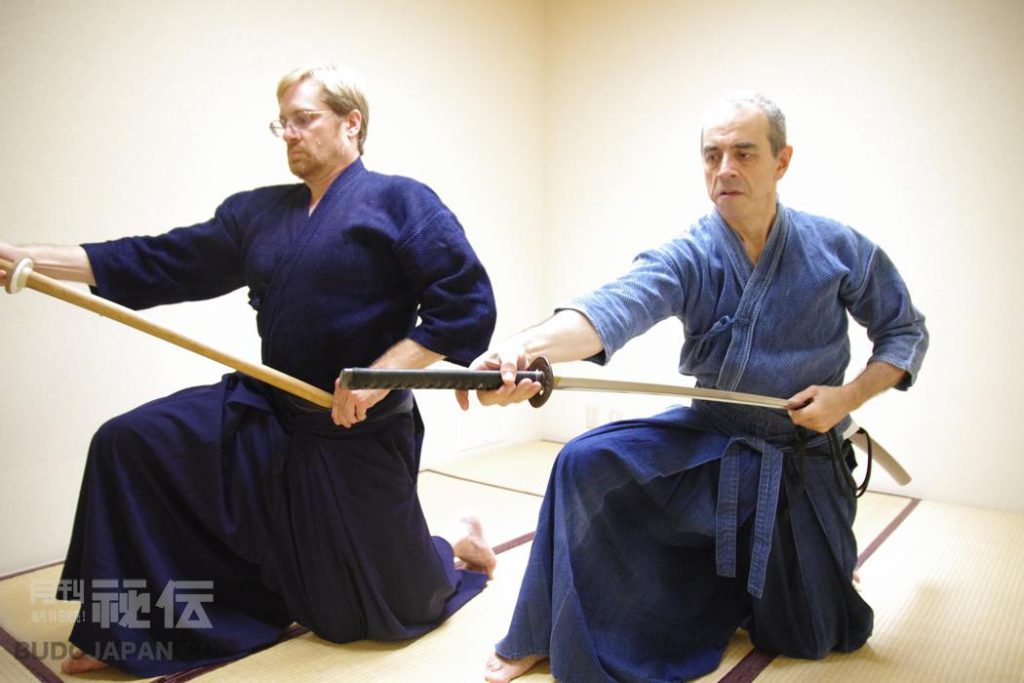
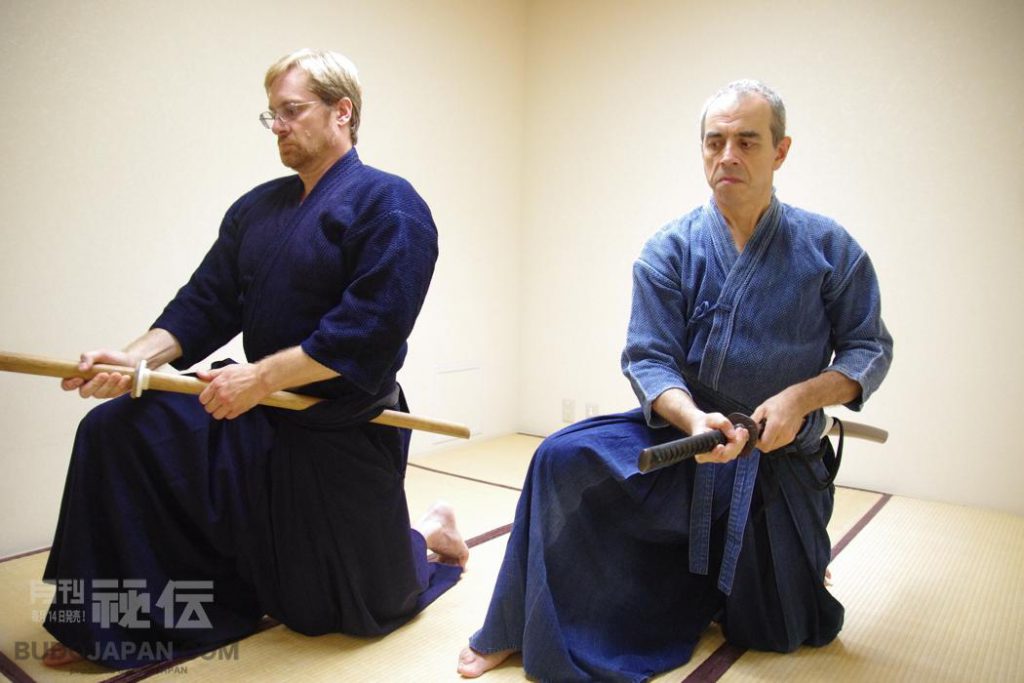
Zanshin
The second characteristic is the 45 degrees to the right side step during zanshin that puts the practitioner about 50cm/1,5 ft further from the fallen opponent; this one was a strategic movement that I was able to decipher without help and Peter confirmed it: the opponent is down but that doesn’t necessarily mean that he’s out! Perhaps he could muster some strength for a final attack on the practitioner’s leg that is closer to him so to make sure that they are out of harm’s way, Shinto Hatakage-ryu swordsmen sidestep a little and then start their chiburi and notto procedure; that this can be found in all three sets shows how important the school’s founders considered it!
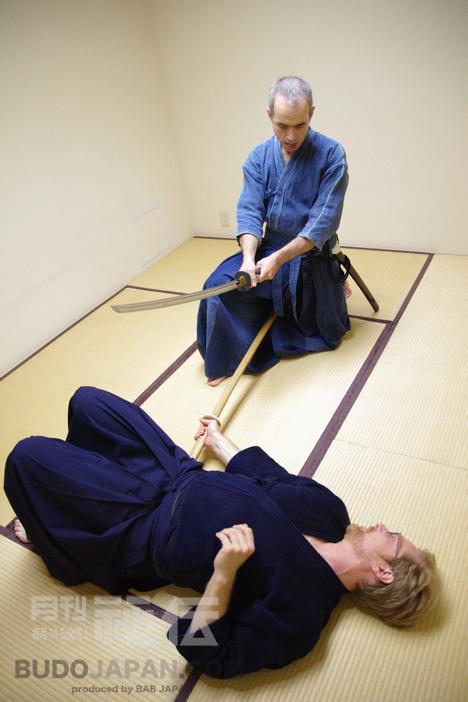
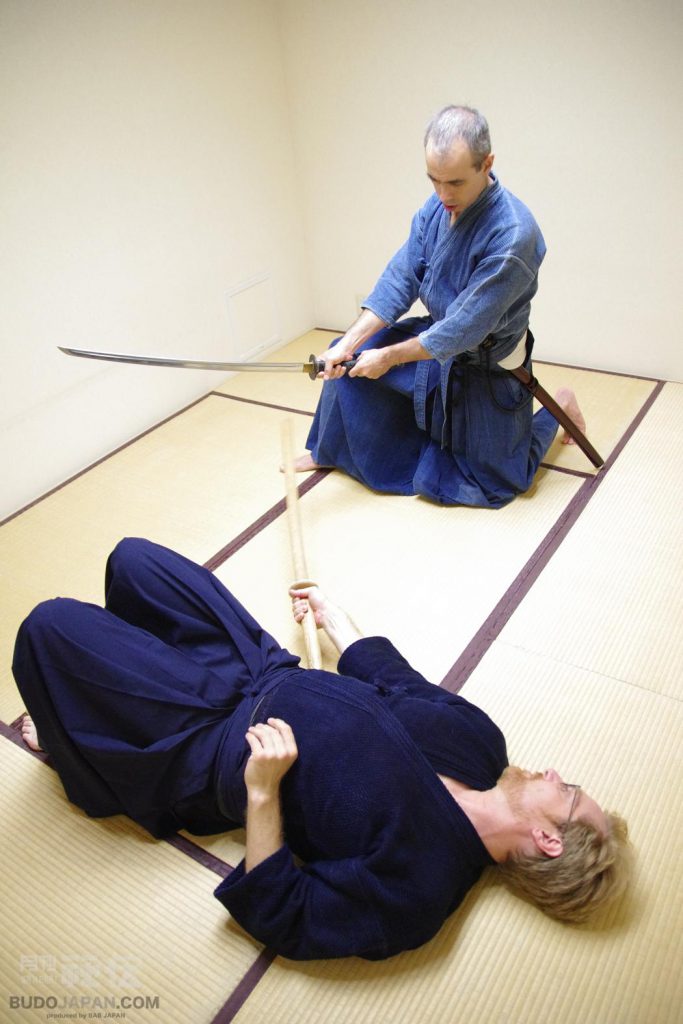
Movement of the saya in noto
The third characteristic is a slight moving up and down of the saya (scabbard) and the sword as the tsuka gets closer to the scabbard’s mouth (koiguchi). I have to admit that for this I had to ask because I couldn’t figure it out; when Peter explained it I felt really stupid because it was the only thing that made sense. Since samurai used to wear a daisho pair of swords and since the short sword was still in place, when re-sheathing the long sword you would need to move it a little so your right hand and the tsuba (hand-guard) wouldn’t hit each other! As a matter of fact, Peter tells me that often in Shinto Hatakage-ryu practice he has his students stick a short sword in their obi so they can really see how to perform this movement.
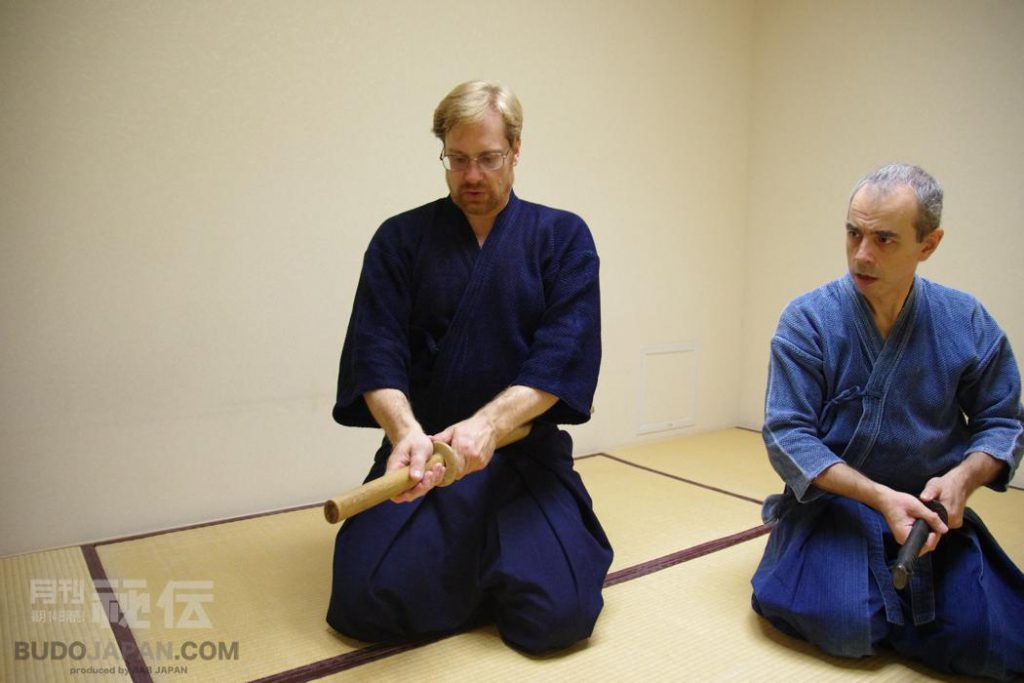
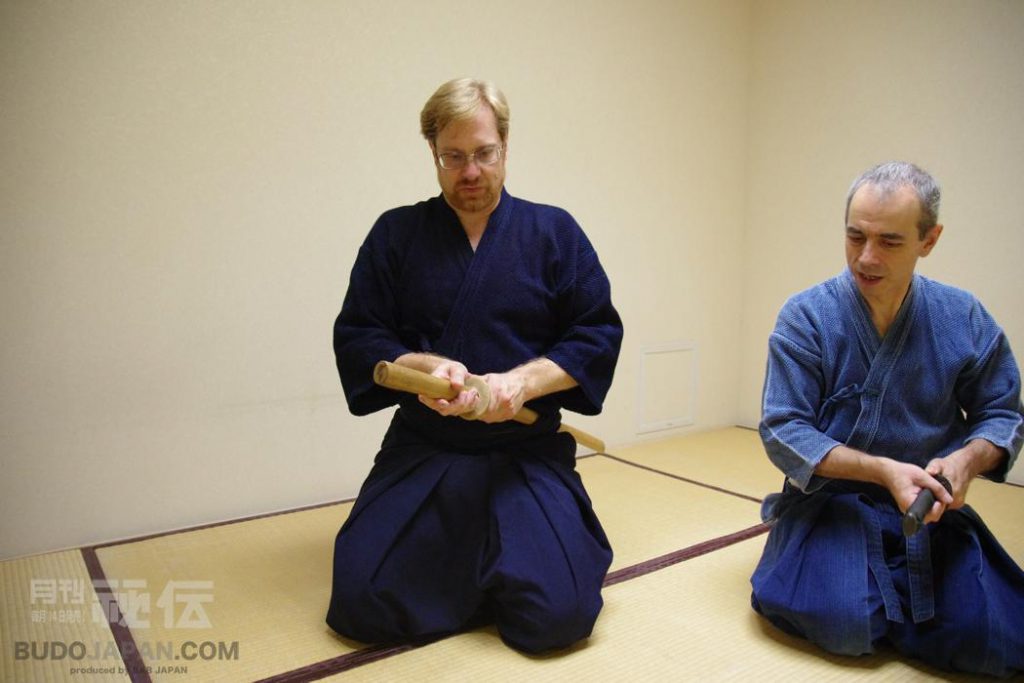
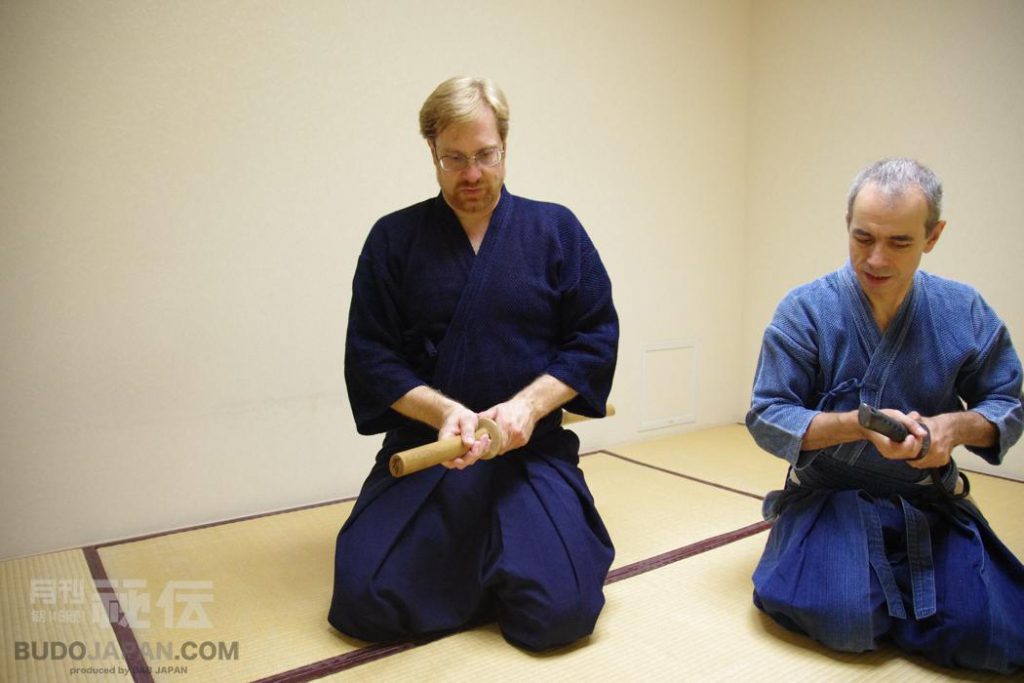
Shinto Hatakage-ryu hands-on
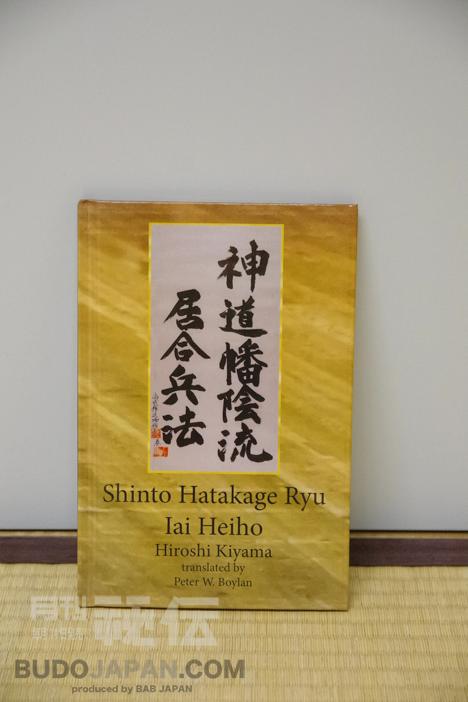
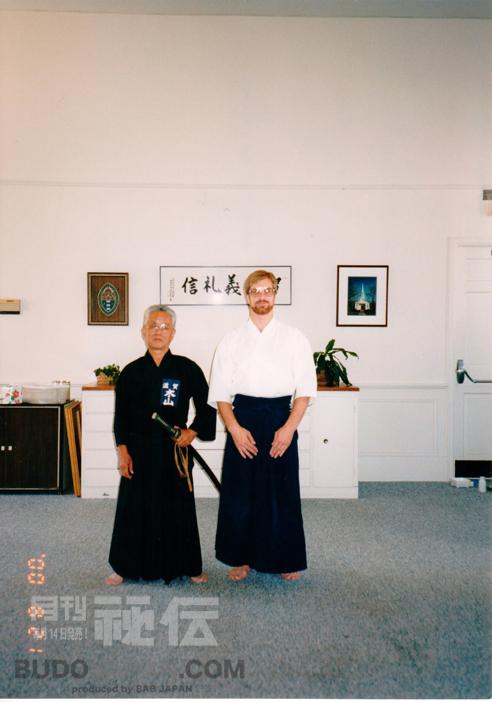 It has been years since that time in Germany but I never forgot that seminar and I’ve often asked Peter about the school and its progress in the US; he and his friend Dr. Debora Klens-Bigman are the only people teaching it outside Japan (Peter lives in Michigan and Dr. Klens-Bigman in New York) so now Shinto Hatakage-ryu exists in one place in Japan and in two places in the US. In the meantime Peter (and Dr. Klens-Bigman) became jun shihan and thus was officially licensed to teach and he also translated and helped get published in English the book “Shinto Hatakage-ryu Iai Heiho” by Hiroshi Kiyama sensei who, incidentally is a 7th dan kyoshi in iaido, kendo and jodo, a 4th dan in jukendo, a 2nd dan in judo and Shito-ryu karate –Peter himself is an AJKF iaido 5th dan and jodo 5th dan, a judo 3rd dan and a Shomokuroku in Shinto Muso-ryu.
It has been years since that time in Germany but I never forgot that seminar and I’ve often asked Peter about the school and its progress in the US; he and his friend Dr. Debora Klens-Bigman are the only people teaching it outside Japan (Peter lives in Michigan and Dr. Klens-Bigman in New York) so now Shinto Hatakage-ryu exists in one place in Japan and in two places in the US. In the meantime Peter (and Dr. Klens-Bigman) became jun shihan and thus was officially licensed to teach and he also translated and helped get published in English the book “Shinto Hatakage-ryu Iai Heiho” by Hiroshi Kiyama sensei who, incidentally is a 7th dan kyoshi in iaido, kendo and jodo, a 4th dan in jukendo, a 2nd dan in judo and Shito-ryu karate –Peter himself is an AJKF iaido 5th dan and jodo 5th dan, a judo 3rd dan and a Shomokuroku in Shinto Muso-ryu.
I had discussed all these with my colleagues in “Hiden” and they had agreed with me: Shinto Hatakage-ryu is interesting enough to grant a presentation in our ongoing “Koryu Experience” series and Peter has been paying his dues long enough to fit nicely in our “Budo No Kuni” videos; from then it was just a matter of finding the right time. Which we finally did a few weeks back, during one of his regular pilgrimages to Japan for preparation for his 6th dan jodo grading. Between the long sessions he had in Shiga and Osaka with his iai and jodo teachers, we asked him to join us for a chat (which you can find on YouTube in https://www.youtube.com/watch?v=Fso1Uqy3QRk) and for a mini Shinto Hatakage-ryu workshop which included the school’s introductory ritual (reishiki) and the kata Mae and Nuki Uchi from Seiza no Bu, Gohonme Tobichigai from Tate Hiza no Bu and Rai Uchi from Tachiwaza no Bu.
Reishiki
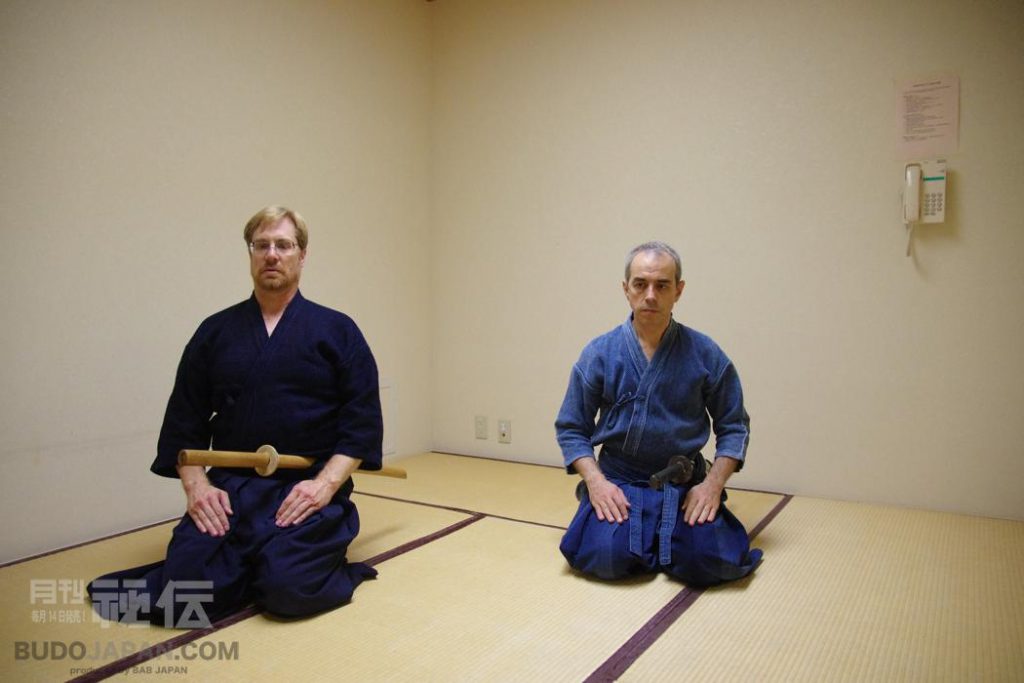 The reishiki of Shinto Hatakage-ryu is rather standard: a sword salute (to-rei) with the sword laid edge out in front of you with the sageo going around the saya’s end (kojiri), a left-right hands down, right-left hands up rise, not very low bow (this is koryu so you don’t really trust anyone!) and then a tucking-in of the sword with the sageo being tied a la Eishin-ryu i.e. near the sword. This isn’t set in stone though: according to Kiyama sensei, it depends on the length of the sageo –practical as usually happens in koryu! The resting position of the sword is with the pommel (tsukagashira) in line with your navel and as you have done that, you’re ready for the first kata.
The reishiki of Shinto Hatakage-ryu is rather standard: a sword salute (to-rei) with the sword laid edge out in front of you with the sageo going around the saya’s end (kojiri), a left-right hands down, right-left hands up rise, not very low bow (this is koryu so you don’t really trust anyone!) and then a tucking-in of the sword with the sageo being tied a la Eishin-ryu i.e. near the sword. This isn’t set in stone though: according to Kiyama sensei, it depends on the length of the sageo –practical as usually happens in koryu! The resting position of the sword is with the pommel (tsukagashira) in line with your navel and as you have done that, you’re ready for the first kata.
Kata: Mae
Shinto Hatakage-ryu isn’t very original: the first kata is Mae, which is pretty much the same as all Mae in all iai systems: a horizontal single-handed cut as soon as the blade is drawn and the right foot steps forward, then the blade travels around the head and the second hand grabs the tsuka and then comes a big overhead cut as the body is propelled forward by the back foot; the cut goes below knee level, again as in many koryu. After that, the blade goes up to seigan, you open with your right foot to the right (the 45 degrees’ detail I mentioned before) while the eyes remain in the front, where the opponent is supposedly lying down, you do the kaiten chiburi, reverse-grip the right hand and do a notto, not forgetting he detail of pulling the tsuka up and then bringing it down for that kodachi detail I also mentioned before. Finally, you stand up and end with the sliding motion that takes the right hand all along the tsuka, makes a short stop on the kashira and then down to the side.
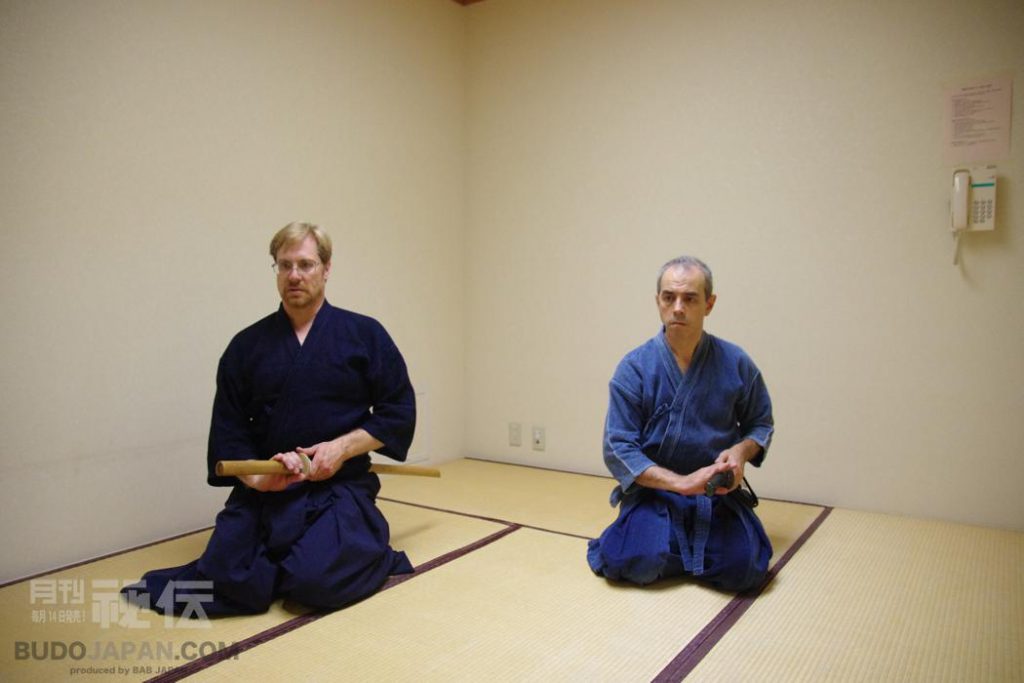
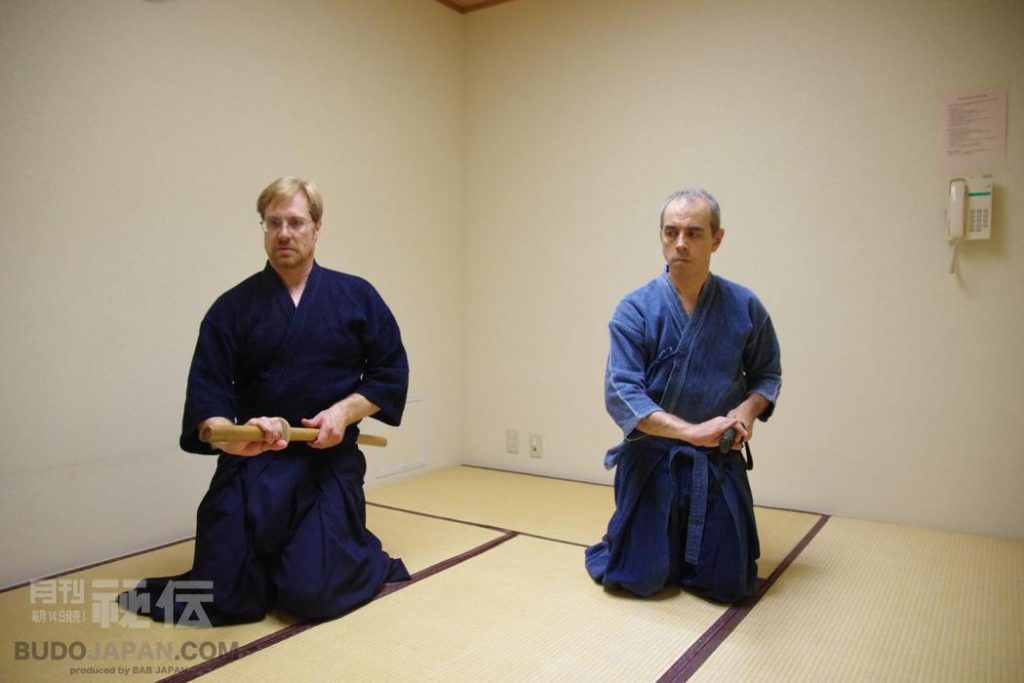
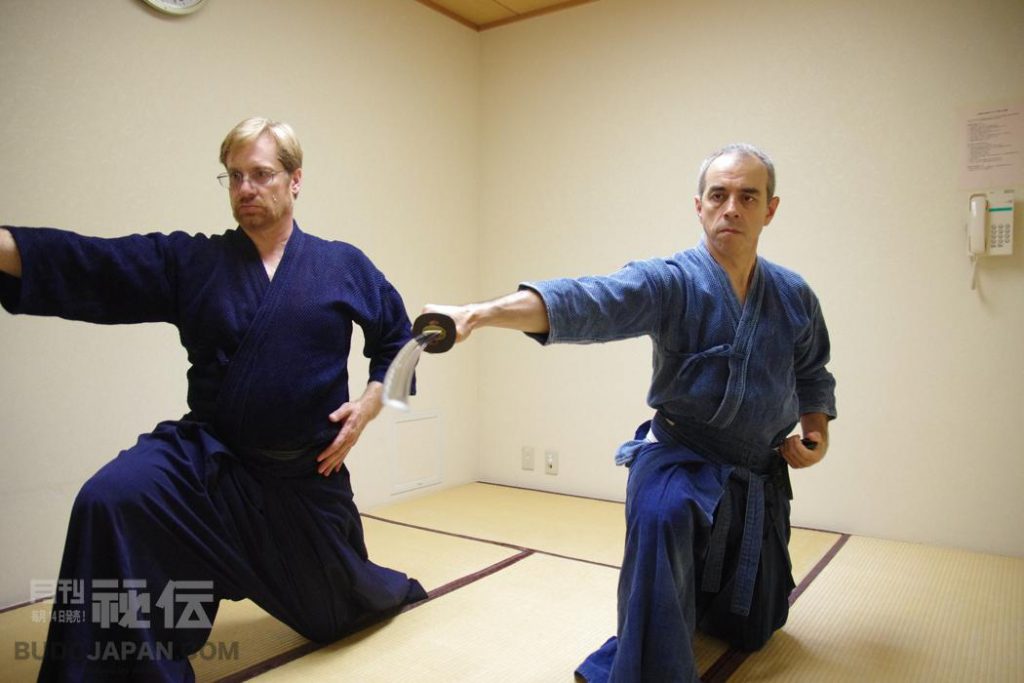
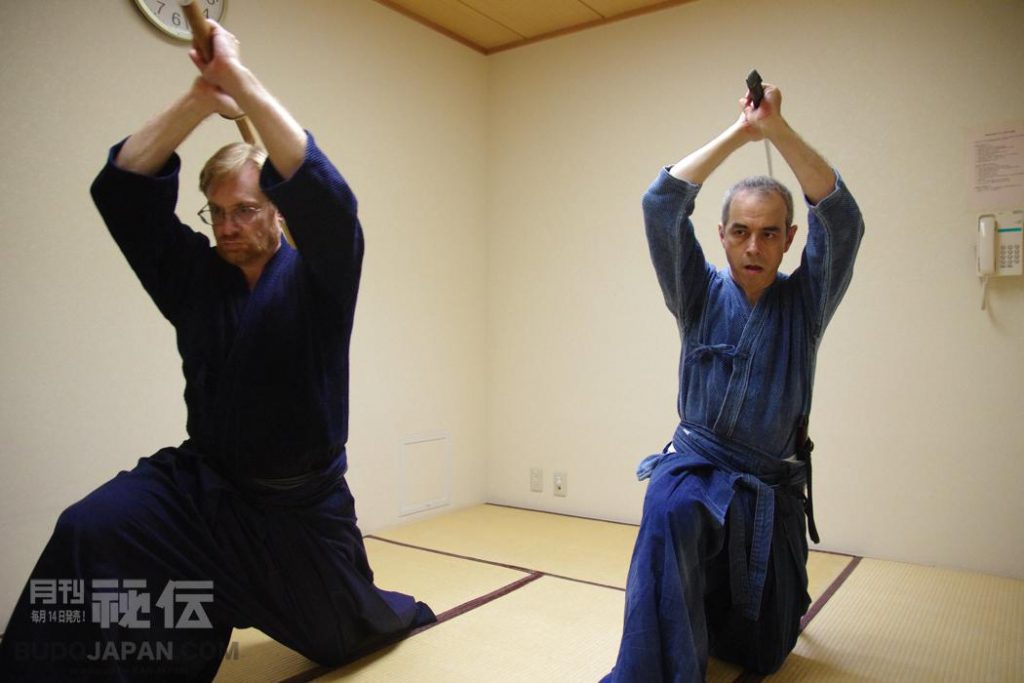
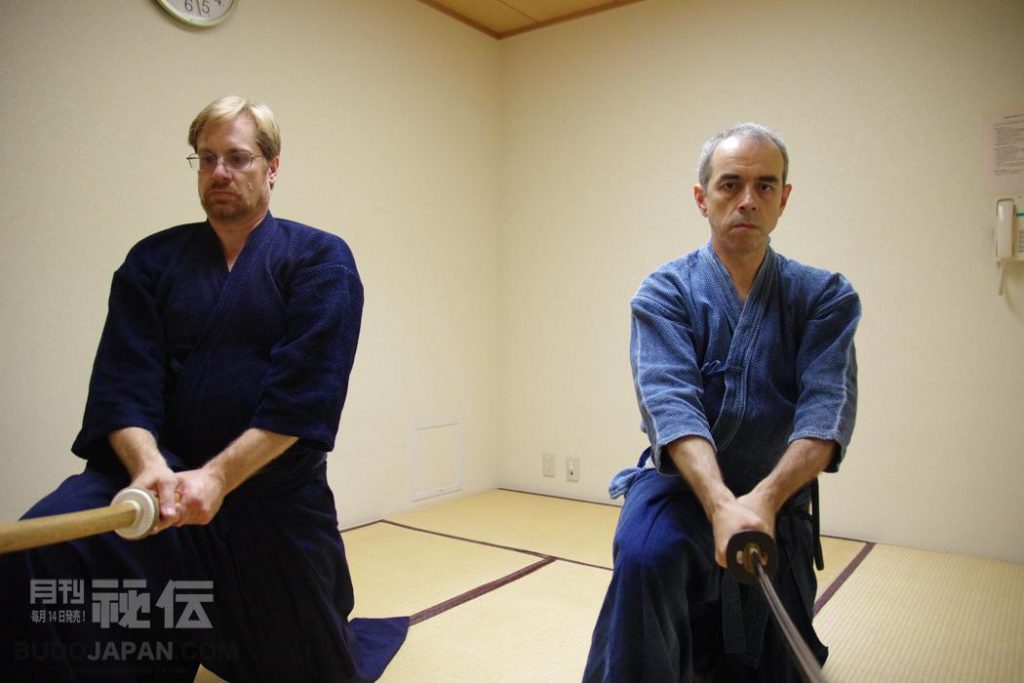
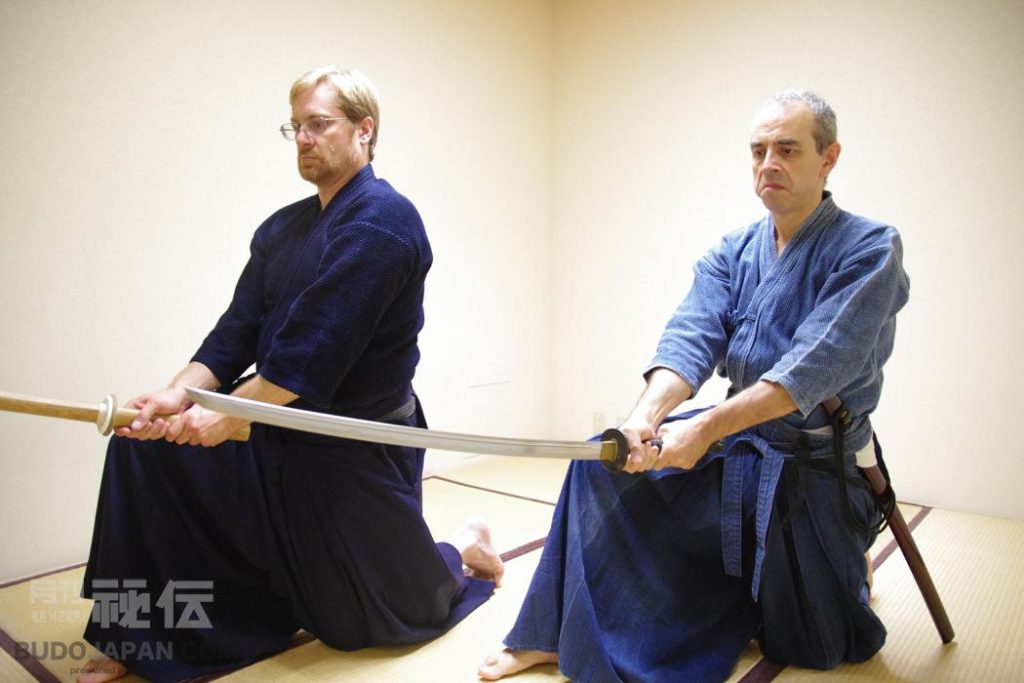
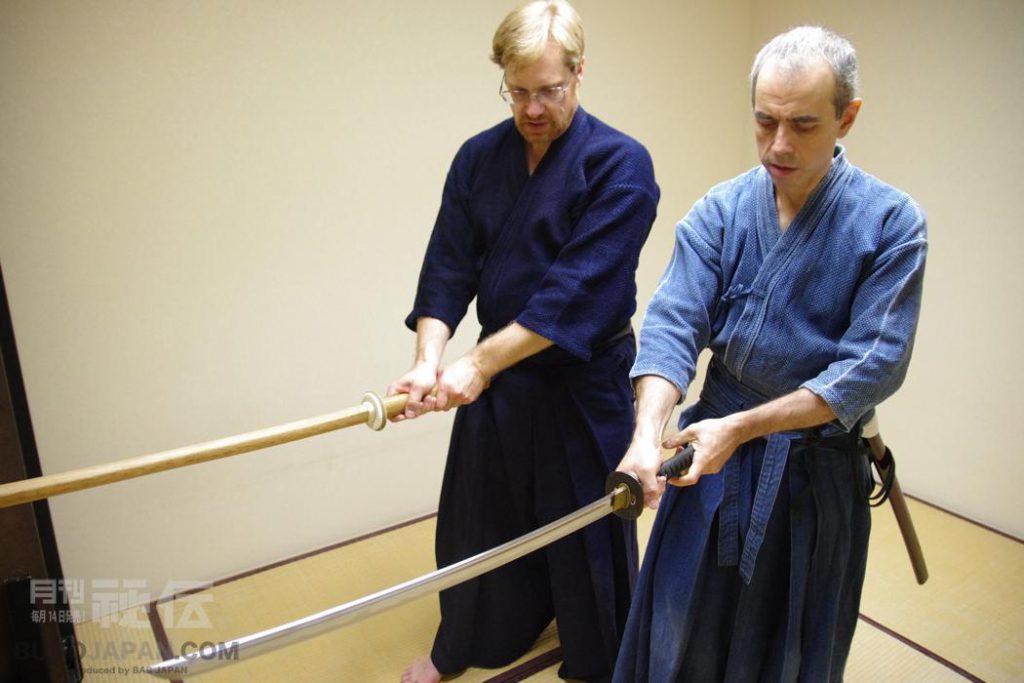 Two more points of notice in Mae that would make the life of someone coming from AJKF iaido difficult are the wide opening between the two legs during the first horizontal cut (the right leg is in a 90 degree angle but the back is left behind and its knee is much more open so the swordsman has covered more space when drawing and cutting) and the close grip of the tsuka: instead of the “spaced by one fist” that is the norm, especially in kendo and the arts related to it, Shinto Hatakage-ryu has both hands close together in the middle of the hilt. This allows for much faster maneuvering of the sword but the change in leveraging will certainly throw most people off and will lead to some very awkward cuts, at least in the beginning; Peter assured me that like everything else, you get used to it!
Two more points of notice in Mae that would make the life of someone coming from AJKF iaido difficult are the wide opening between the two legs during the first horizontal cut (the right leg is in a 90 degree angle but the back is left behind and its knee is much more open so the swordsman has covered more space when drawing and cutting) and the close grip of the tsuka: instead of the “spaced by one fist” that is the norm, especially in kendo and the arts related to it, Shinto Hatakage-ryu has both hands close together in the middle of the hilt. This allows for much faster maneuvering of the sword but the change in leveraging will certainly throw most people off and will lead to some very awkward cuts, at least in the beginning; Peter assured me that like everything else, you get used to it!
Kata: Nuki Uchi
Moving on to Nuki Uchi, if you’re coming from Muso Jikiden Eishin-ryu, you will recognize the final cut as what you are doing in Makko, #10 of the school’s Tate Hiza no Bu (in Muso Shinden-ryu, it’s Chuden’s #10, Nukiuchi). From seiza and with two opponents, one in front of you and one behind you, you rise slowly while drawing and keeping the front opponent in check with your kashira, then when the sword is drawn you turn your torso back, bring the sword horizontally a little below breast height and do a deep one-hand thrust to the back, turn front, bring the sword around your head, grab with the left hand and perform a very deep cut in the front while sinking your weight and opening your seiza as much as your hip joints allow -like in the other schools, this way you can put a lot of power behind your cut even though you are sitting down. After that, the sword goes up in seigan and, because the position of the body doesn’t allow for a kaiten chiburi, you finish with a standard yoko chiburi, standard notto and return to seiza.
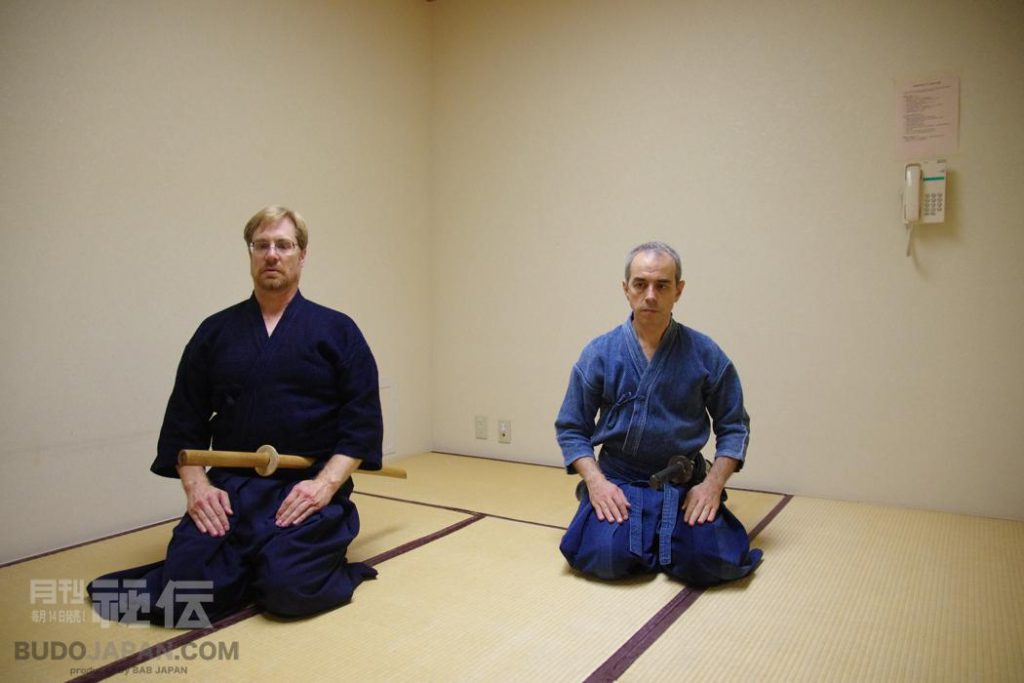
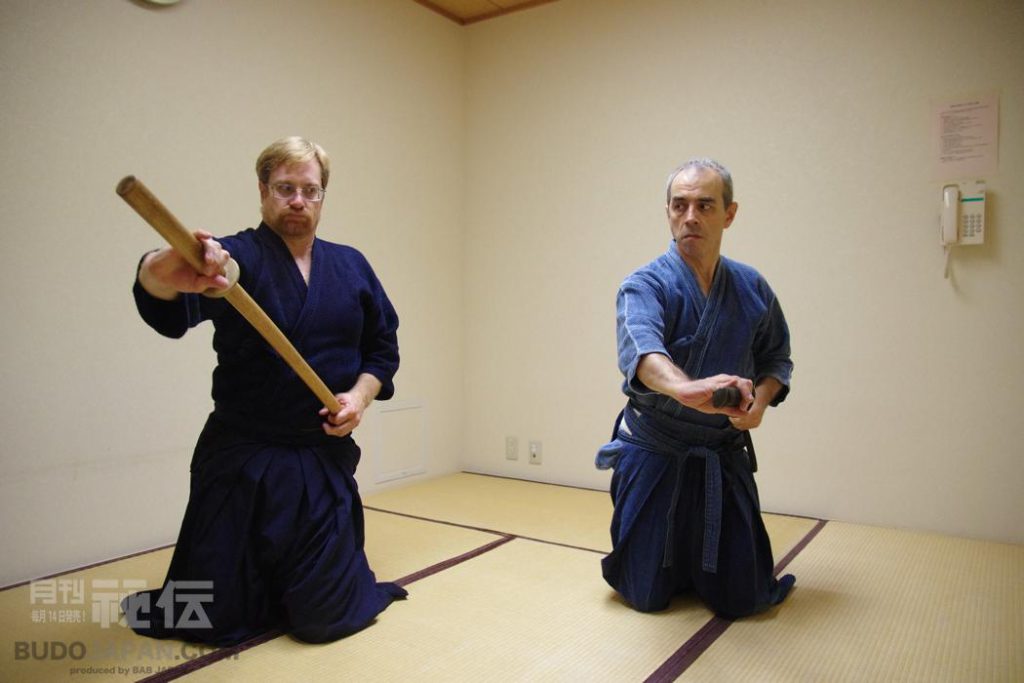
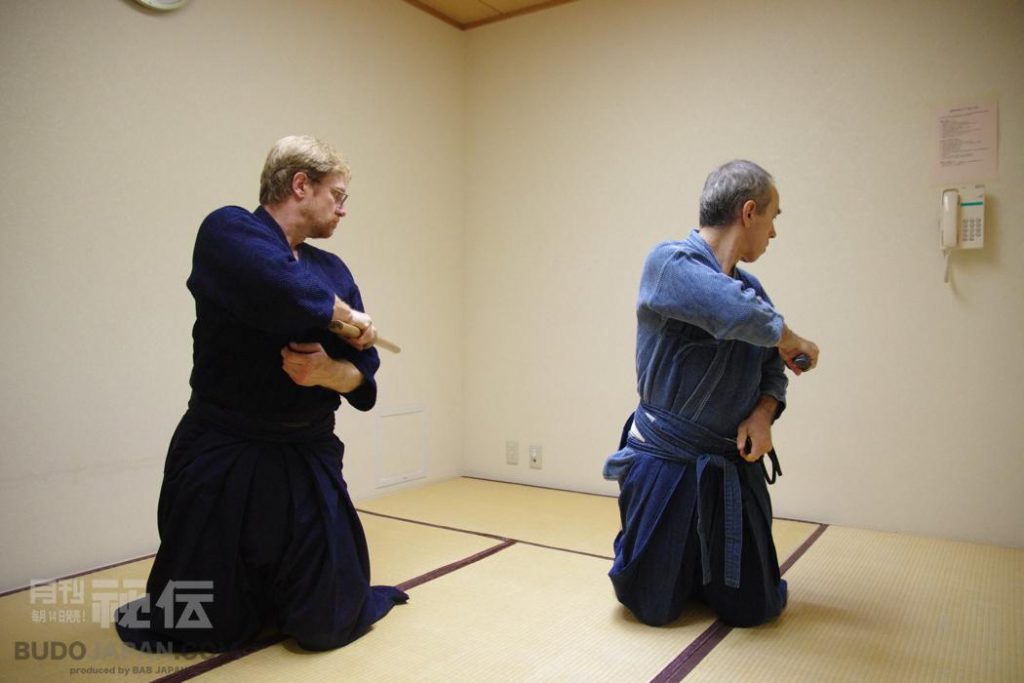
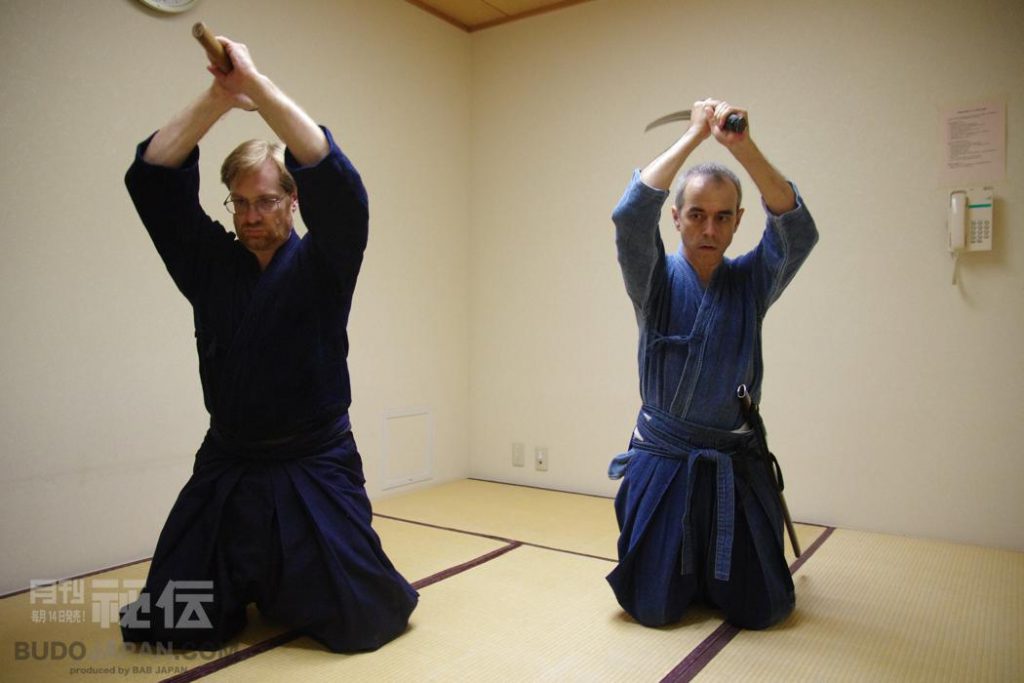
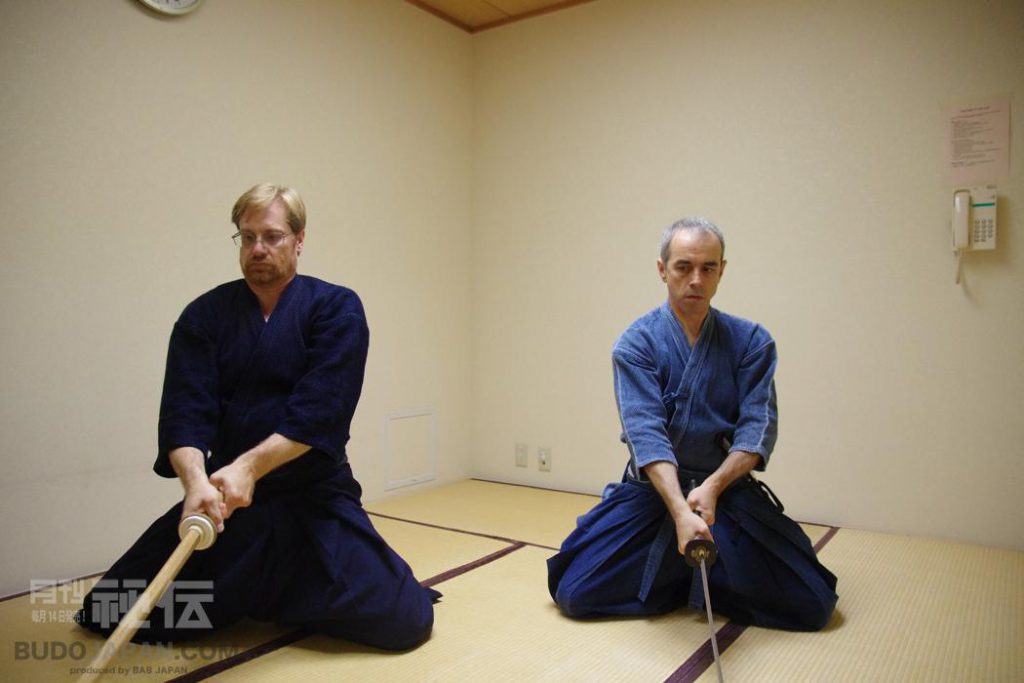
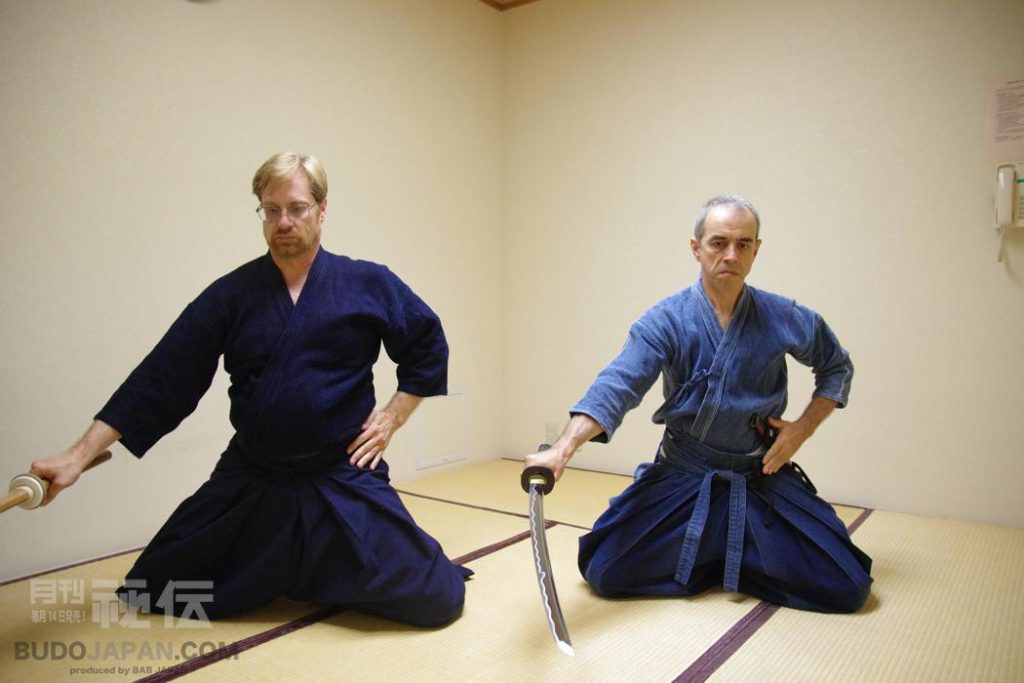
Kata: Tobichigai
Gohonme/Tobichigai from Tate Hiza no Bu is interesting because it features two rather original elements. The scenario has three opponents at front, right and left so you first draw pushing the front opponent with the kashira, turn to the right and threaten that opponent on the face with it while standing the right foot down, draw fully the sword and do a single hand thrust to the left opponent, return to the opponent on the right and cut them and then change feet and cut the front opponent with the left foot forward. Then you change feet, while bringing the sword to seigan, do the side step, perform kaiten chiburi and reverse hand notto and stand up. The interesting bits are that (a) when you cut the opponent to the right, you cut outside your standing right knee and (b) when you change feet to cut the front opponent, you do it jumping –this is what gives the kata its name: “tobu” means “to jump” and “chigau” means “to differ”.
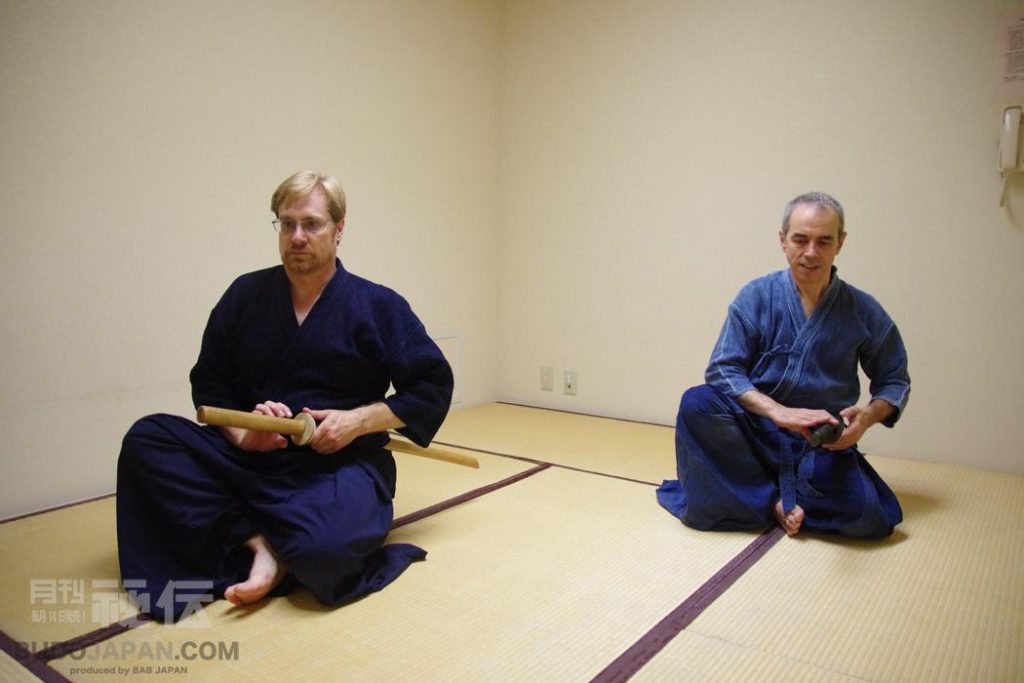
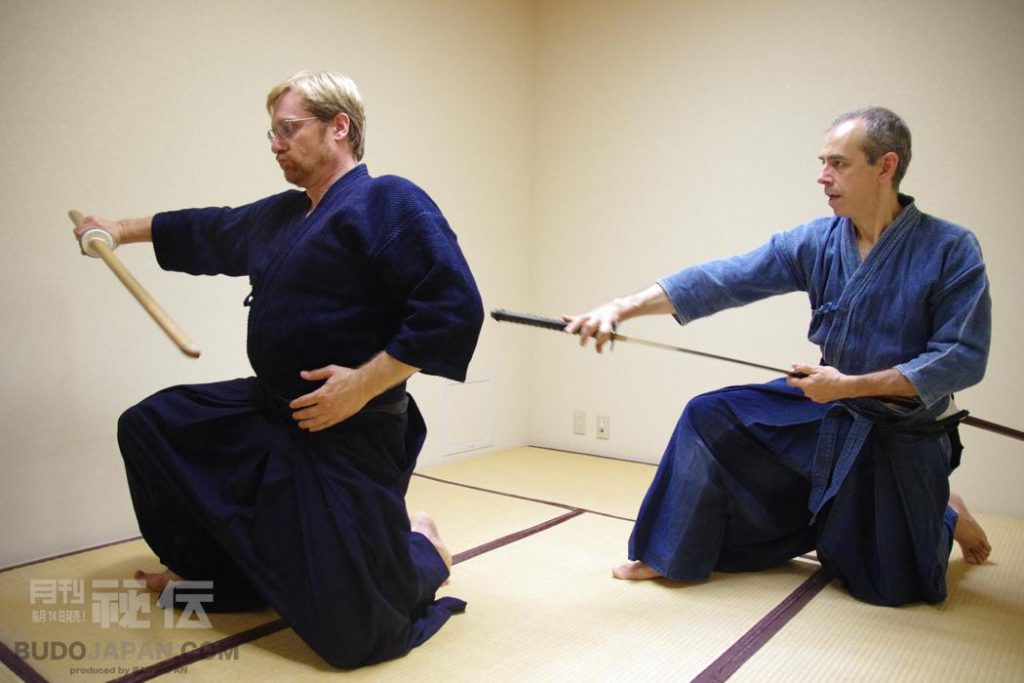
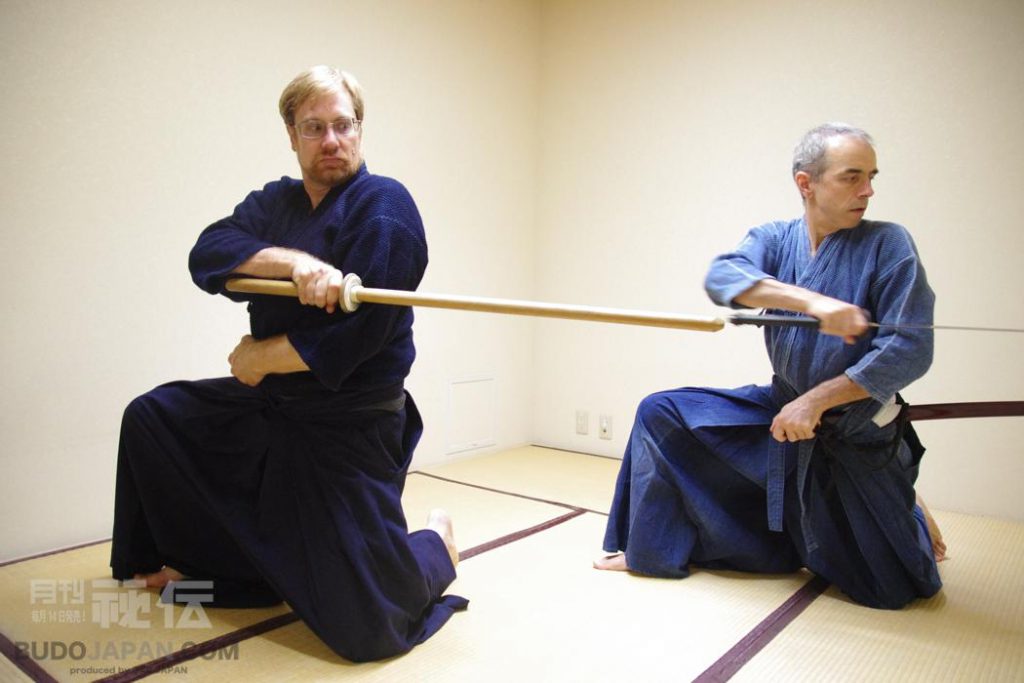
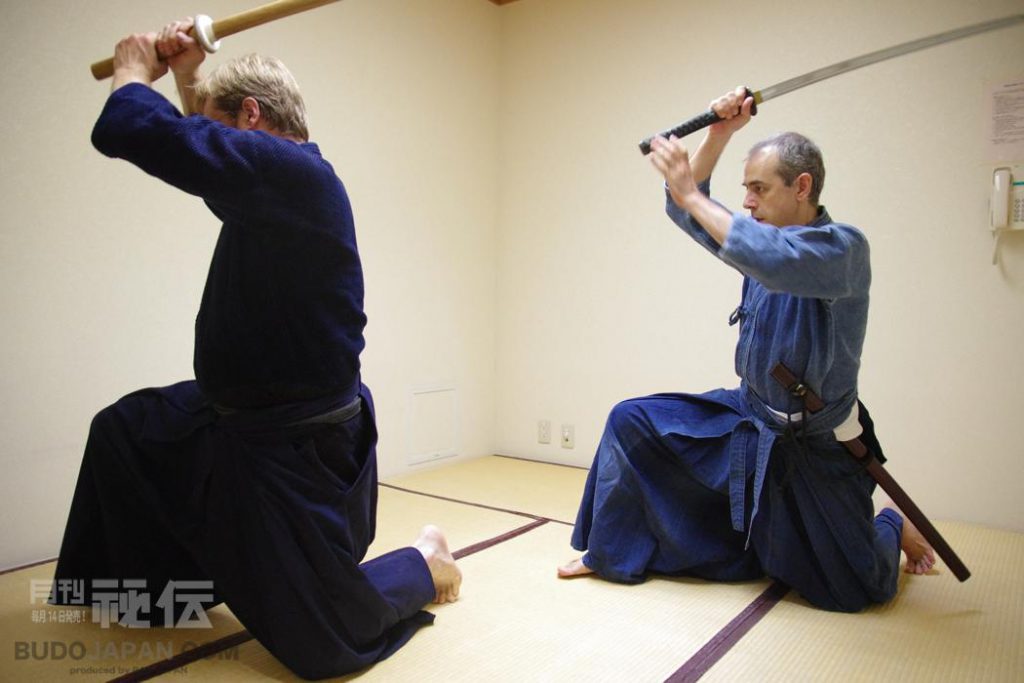
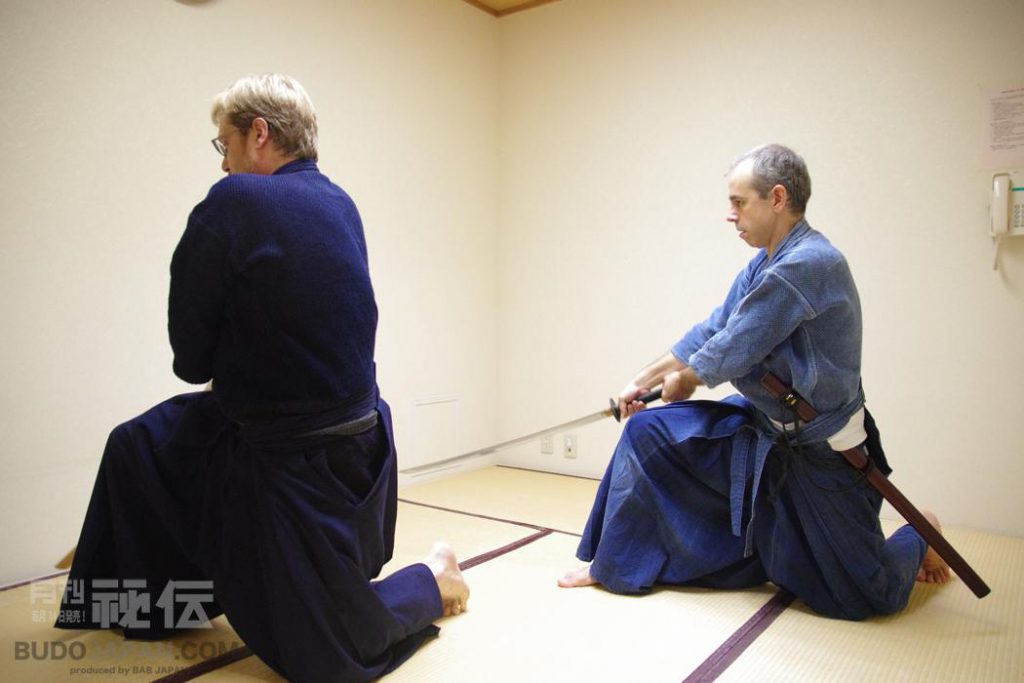
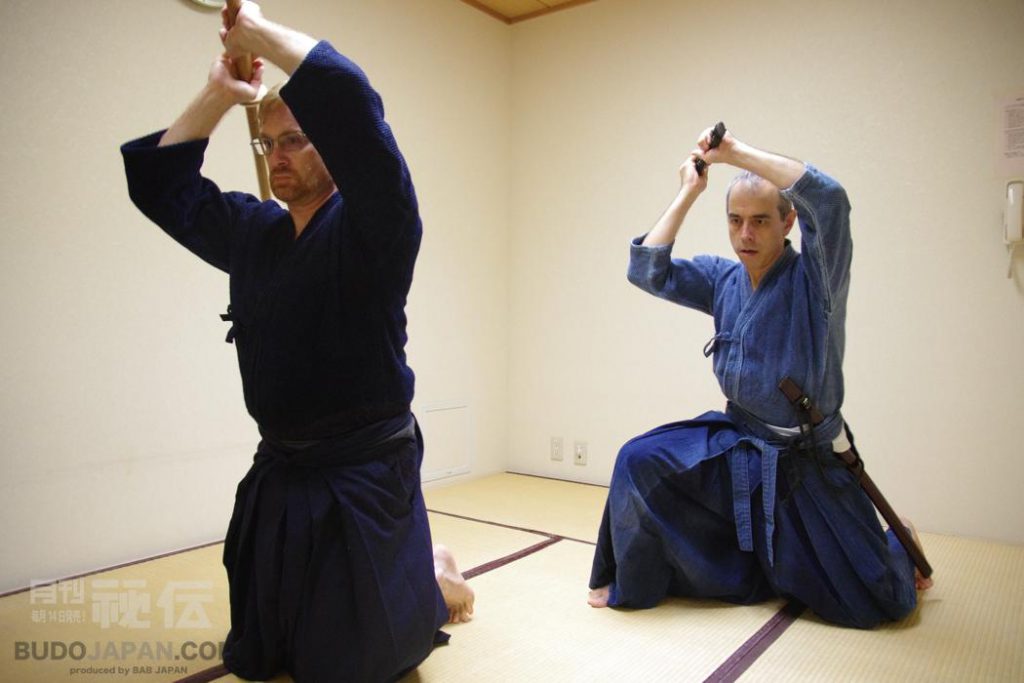
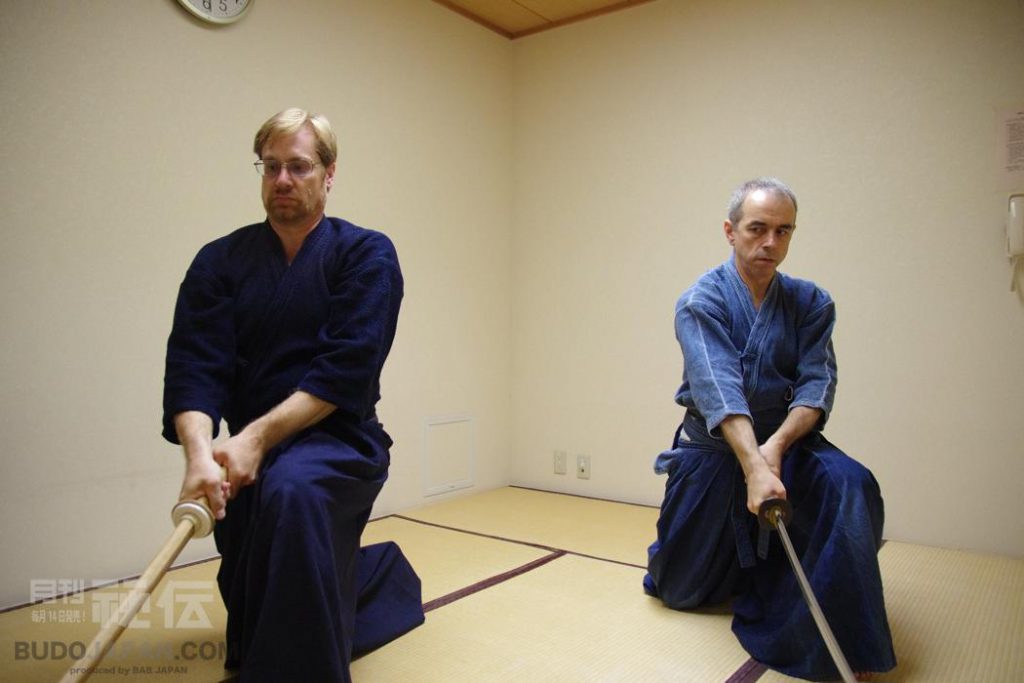
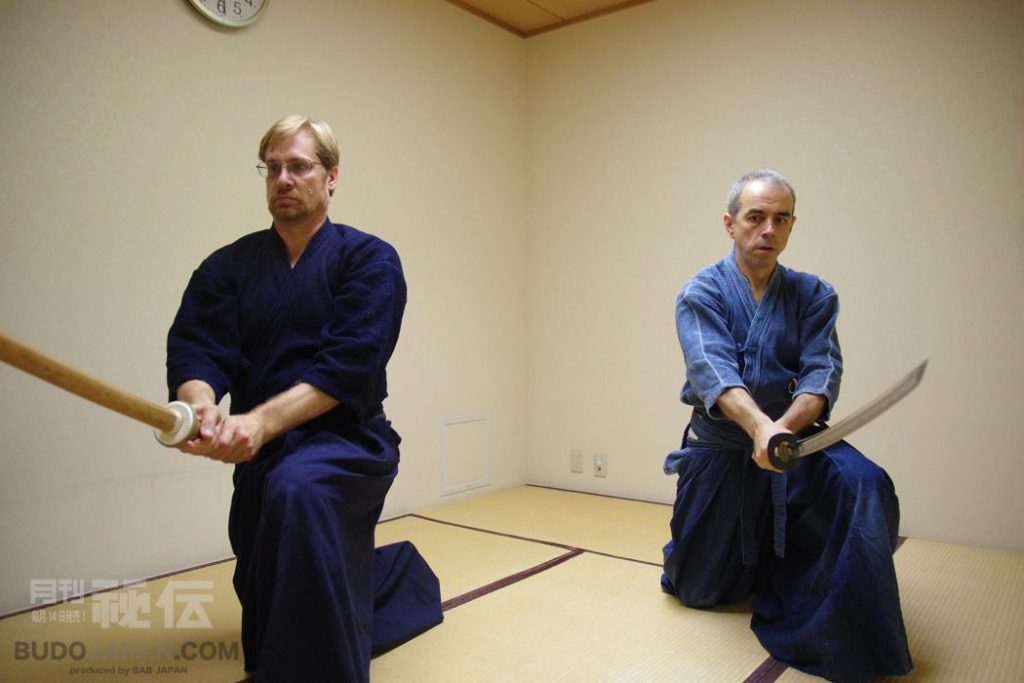
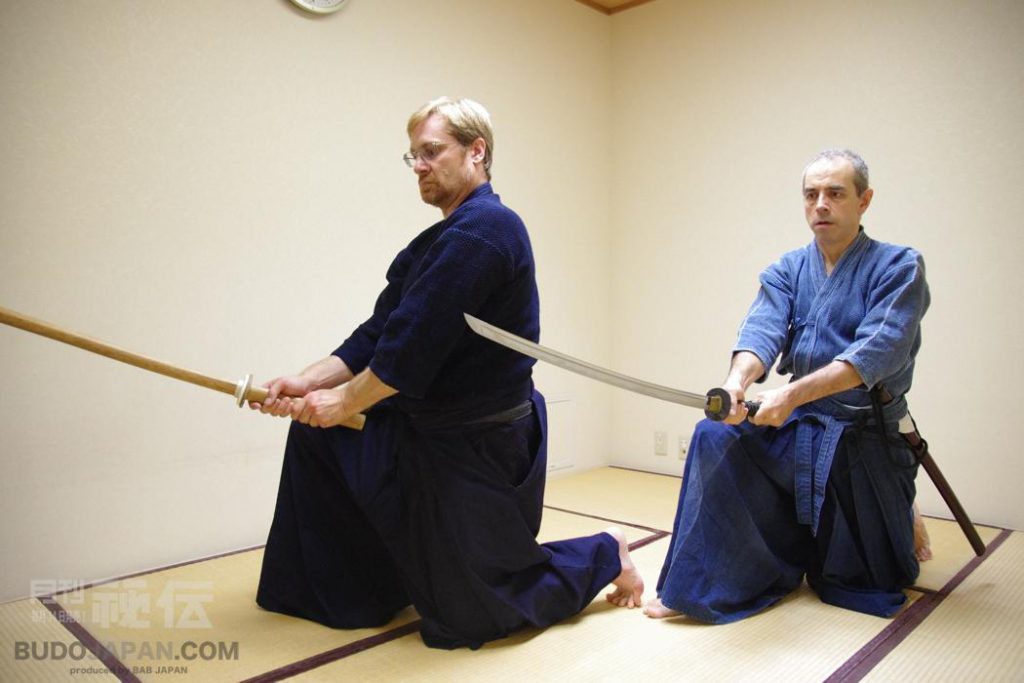
Kata: Rai Uchi
The last kata we worked was Rai Uchi from the Tachiwaza no Bu. Here, there’s only one opponent coming at you from the front while walking so as soon as you detect their intention you hit him on the solar plexus with your tsuka kashira, you draw fully the sword and bring it around your head and perform a deep cut, well below waist level while also stomping on the ground with your right foot, like a kendo fumikomi ashi. After the opponent is down, you raise the sword to seigan, you don’t have the side step and you perform a standard yoko chiburi -why this happens although there is space for the kaiten chiburi is something that no one really knows.
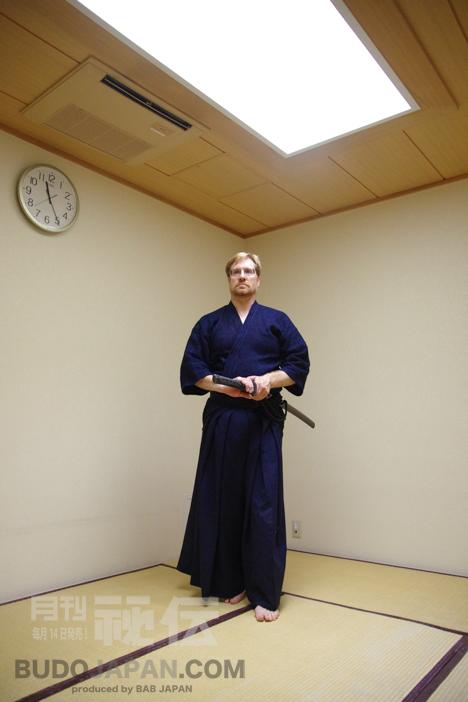
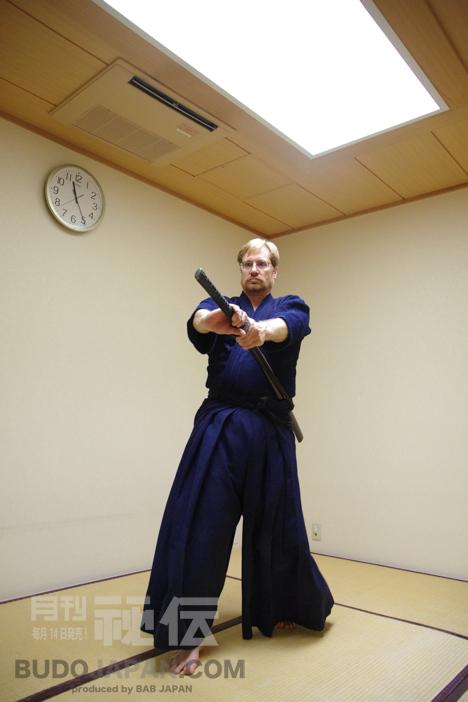
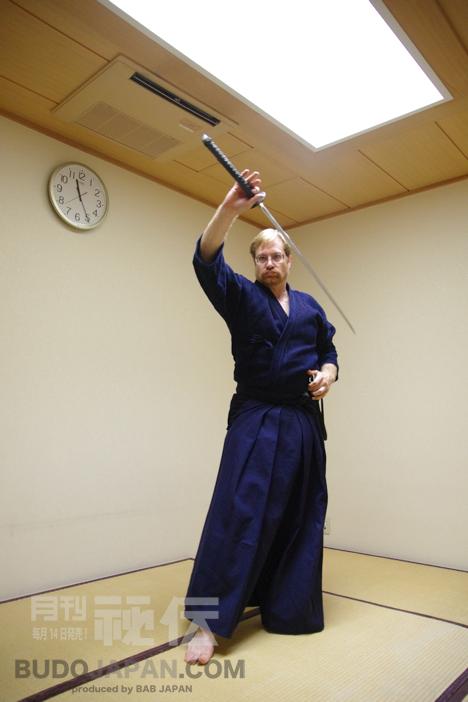
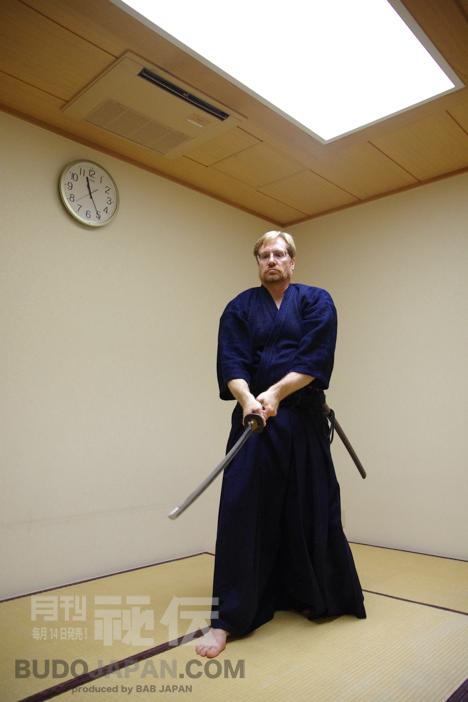
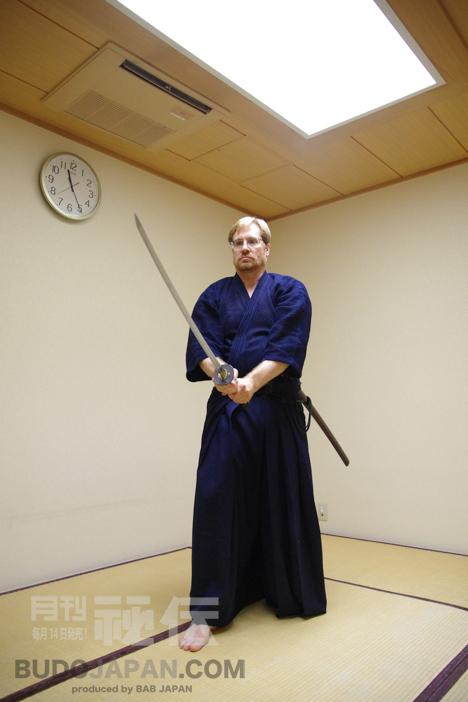
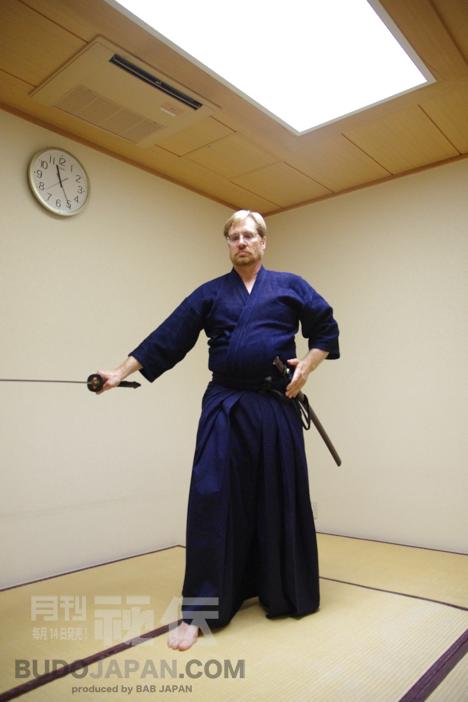
Shinto Hatakage-ryu’s future
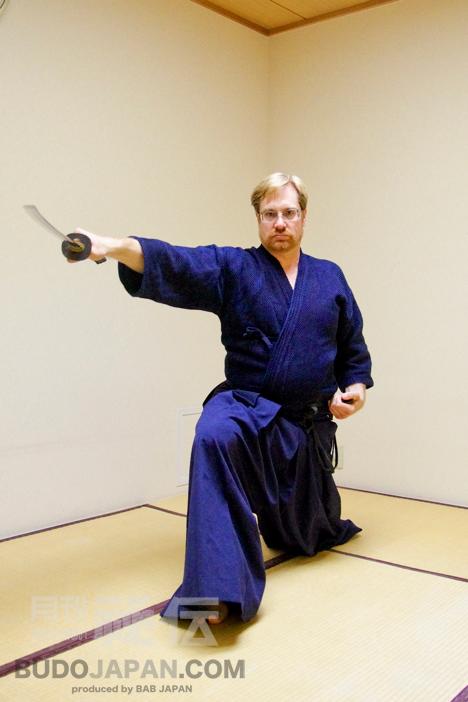 Doing iai after many years was fun -doing it with a good friend was even better and I really enjoyed it. Shinto Hatakage-ryu might only have a handful of students with most of them far from its birthplace but both Peter Boylan and Dr. Klens-Bigman are people with a very deep relationship with Japan so there is no doubt in my mind that they will do their best to keep it alive and transmit it to the future generations. Despite the few particular characteristics I mentioned in this article, it isn’t fancy but very down-to-earth and helps its student develop instincts that will suit them in several situations, both sitting and standing/moving. It small curriculum means that you can really focus on advancing your art without having to navigate through hundreds of techniques and it can stand its ground next to the Big Two i.e. Muso Jikiden Eishin-ryu and Muso Shinden-ryu; perhaps now that Peter is becoming more well-known thanks to his book, it will find the recognition it deserves.
Doing iai after many years was fun -doing it with a good friend was even better and I really enjoyed it. Shinto Hatakage-ryu might only have a handful of students with most of them far from its birthplace but both Peter Boylan and Dr. Klens-Bigman are people with a very deep relationship with Japan so there is no doubt in my mind that they will do their best to keep it alive and transmit it to the future generations. Despite the few particular characteristics I mentioned in this article, it isn’t fancy but very down-to-earth and helps its student develop instincts that will suit them in several situations, both sitting and standing/moving. It small curriculum means that you can really focus on advancing your art without having to navigate through hundreds of techniques and it can stand its ground next to the Big Two i.e. Muso Jikiden Eishin-ryu and Muso Shinden-ryu; perhaps now that Peter is becoming more well-known thanks to his book, it will find the recognition it deserves.
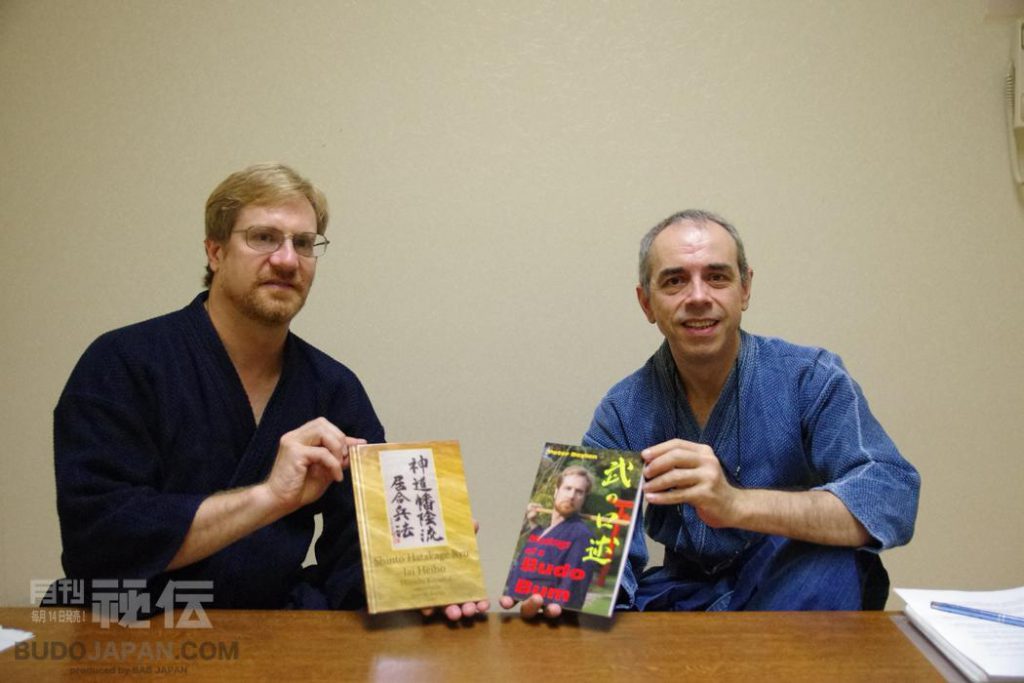
 About the author
About the author
Grigoris Miliaresis has been practicing Japanese martial arts since 1986. He has dan grades in judo, aikido and iaido and has translated in Greek over 30 martial arts’ books including Jigoro Kano’s “Kodokan Judo”, Yagyu Munenori’s “The Life-Giving Sword”, Miyamoto Musashi’s “Book of Five Rings”, Takuan Shoho’s “The Unfettered Mind” and Donn Draeger’s “Martial Arts and Ways of Japan” trilogy. Since 2007 his practice has been exclusively in classic schools: Tenshin Buko-ryu Heiho under Ellis Amdur in Greece and Kent Sorensen in Japan and, since 2016, Ono-ha Itto-ryu under 17th headmaster Sasamori Takemi and 18th headmaster Yabuki Yuji.
http://about.me/grigorismiliaresis







